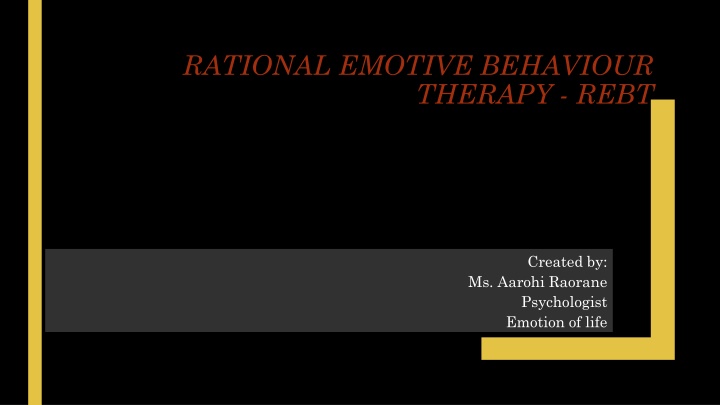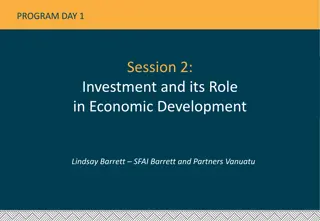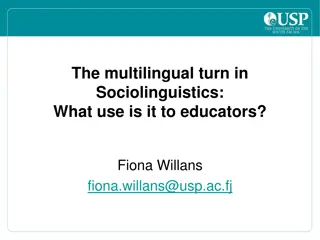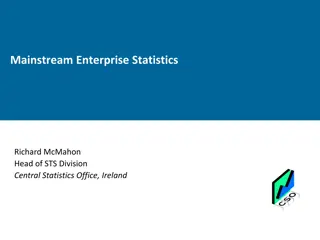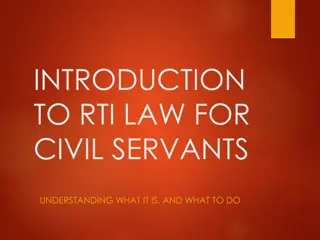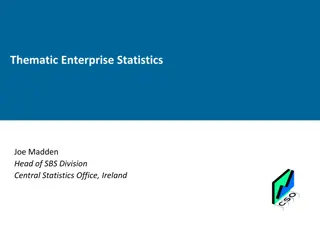Vanuatu National Statistics Office Progress Report
Vanuatu National Statistics Office (VNSO) is making significant strides in achieving its objectives for managing statistical collections, producing high-quality statistics, and improving regional statistics governance. The office has implemented structural changes, collaborated with various partners, and is leading the revision of the National Strategy for the Development of Statistics. VNSO's efforts aim to enhance data collection, dissemination, and stakeholder engagement, ultimately supporting evidence-based decision-making and sustainable development in Vanuatu.
Download Presentation

Please find below an Image/Link to download the presentation.
The content on the website is provided AS IS for your information and personal use only. It may not be sold, licensed, or shared on other websites without obtaining consent from the author.If you encounter any issues during the download, it is possible that the publisher has removed the file from their server.
You are allowed to download the files provided on this website for personal or commercial use, subject to the condition that they are used lawfully. All files are the property of their respective owners.
The content on the website is provided AS IS for your information and personal use only. It may not be sold, licensed, or shared on other websites without obtaining consent from the author.
E N D
Presentation Transcript
RATIONAL EMOTIVE BEHAVIOUR THERAPY - REBT Created by: Ms. Aarohi Raorane Psychologist Emotion of life
What is REBT? Developed by Albert Ellis in early 1950s REBT is a therapeutic approach which focuses on your irrational beliefs and negative thought patterns and tries to change it to Rational Beliefs and thought patterns. Ellis realized that people experience psychological disturbance not because of the events happening around them but because of how people perceive the events that happen around them. He emphasized that what we think we also feel and behave His work was influenced by a lot of Greek and Roman philosophers, Modern Philosophers like Immanuel Kant and Research Philosopher like Popper. It takes more active-directive approach in a therapeutic setting REBT takes an integrative approach i.e. it focuses on emotions, behaviors, feelings and operates in this framework REBT is also has an eclectic approach i.e. it takes elements from various different forms of therapy like: Unconscious motives and defense systems as Freudian do Roger s unconditional positive regard/ acceptance Adler encourages clients to change Skinnerian s and behaviorist give Homework assignments, use operant conditioning, employ in vivo desensitization; and so on
Thought, feelings and Behavior are not independent of each interconnected, they influence each other other but rather
The REBT Model of Emotion REBT is primarily concerned reliving people of their emotional disturbances, However, it also acknowledges that people are bound to have negative emotions when faced with negative life events. To accommodate these two positions REBT distinguishes between emotions that are negative in tone and have largely unconstructive consequences and emotions that are negative in tone and have largely constructive consequences. The former are known as unhealthy negative emotions (UNEs UNEs) and the latter healthy negative emotions (HNEs To simplify it let s start with unhealthy negative emotions, some examples of these are Anxiety, depression, guilt, unhealthy anger, shame, hurt, unhealthy jealousy, unhealthy envy. These emotions are unhealthy because it hinders our ability to achieve a goal or desire. Whereas healthy negative emotions are concern, sadness, remorse, disappointment, healthy anger, sorrow, healthy envy; healthy negative emotions are those who helps and motivate us in achieving our goals and desires in life. The REBT model of emotion states that the emotions that we experience are based largely on the beliefs that we hold about ourselves, others and the world. More specifically it states that our unhealthy negative emotions about life s adversities are based largely on the irrational beliefs that we hold about these adversities and that if we want to experience healthy negative emotions about the adversities in question we need to change our irrational beliefs to rational beliefs. HNEs).
Unhealthy negative emotions vs Healthy negative emotions Unhealthy Negative Emotions (UNE) Unhealthy Negative Emotions (UNE) 1. Anxiety Healthy Negative Emotions (HNE) Healthy Negative Emotions (HNE) 1. Concern 2. Depression 2. Sadness 3. Guilt 3. Remorse 4. Shame 4. Disappointment 5. Unhealthy Anger 5. Healthy Anger 6. Hurt 6. Sorrow/Disappointment 7. Unhealthy Envy 7. Healthy Envy 8. Unhealthy Jealousy 8. Healthy Jealousy
Themes of UNE and HNE Anger- we anticipate negative consequences, start avoiding things Concern- though we are tensed about the event we are more likely to face the event and approach it Depression- feeling of hopelessness, no meaning in life Sadness- experience of loss, mourning but hopeful Guilt- When we break/violate our own moral codes, personal norms, try to punish ourself Remorse- Upset about violating our norms but there s no self-punishment Shame- when we violate social norms, fear criticism from society, most common in Socialized anxiety disorder and Avoidant Personality disorder Disappointment- we feel displeased because we haven t met but social norms but we try to improve Unhealthy Anger- we experience this when other break or don t follow our rules Healthy anger- it is more flexible than healthy anger, we try to solve the problem instead of blaming others.
Themes of UNE and HNE Hurt- this happens when our expectations are unmet Sorrow/Disappointment- we feel displeased because our expectations aren t met but we try to resolve the conflict Unhealthy Envy: More materialistic oriented, we compare ourselves with others on the basis of power, status, materialistic achievement Healthy Envy: We get inspired and motivated to achieve those things that we don t have Unhealthy Jealousy- People oriented, we feel insecure, possessive about our partners or in interpersonal relationships Healthy Jealousy- this experience leads us to safeguard our relationships, take more efforts to appreciate and express gratitude towards our loved one.
Irrational Beliefs and Rational Beliefs Irrational in REBT means that which prevents us from achieving our goals and purposes" And Rational in REBT means that which helps people to achieve their basic goals and purposes Hence the meaning of rational and irrational isn t absolute but rather more relative in nature. Rational Beliefs Rational Beliefs Irrational Beliefs Irrational Beliefs Self-helping Self- defeating Flexible, adaptive, productive, consistent with social reality Rigid, dogmatic, unhealthy, maladaptive, inconsistent with social reality Helping the group to survive and to achieve its basic goals Interfering with the group survival and wellbeing Unbalance between self and social interests The balance between self and social interests
Irrational Beliefs There are four types of Irrational Beliefs 1. 1. Demands Demands: These are the primary Irrational belief. They often feature phrases such as must, absolute shoulds, have to, need and ought. Example: I would love to succeed and therefore I have to! 2. 2. Awfulising Awfulising: In REBT awful is defined as anything that is evaluated as being worse than 100% bad. Example: If I don't succeed in my presentation is will be awful! 3. 3. Low Frustration Tolerance (LFT): Low Frustration Tolerance (LFT): Otherwise known as I-can't-stand-it-itis, LFT beliefs feature an acknowledgement of a struggle and an assertion that the struggle is truly unbearable or cannot be stood. Example: If people are rude to me I cannot stand it! 4. 4. Conditional Self (other, life) Acceptance Conditional Self (other, life) Acceptance: Otherwise known as self-downing, this is where we define our self based on one aspect. Example: If I fail at something important to me then I am a failure! It is also called as global evaluation of self, others or world.
Rational Beliefs There are four types of Rational Beliefs 1. 1. Preferences Preferences - Rather than demanding, preferring is a much more helpful attitude to have about life. Example: I would love to succeed but I don't have to. 2. 2. Anti Anti- -awfulising awfulising: Nothing in this world could not be worse, and anti-awfulising beliefs reflect this. Example: If I don't succeed in my presentation, it may be bad but never truly awful! 3. 3. High Frustration Tolerance (HFT): High Frustration Tolerance (HFT): Usually, we tell ourselves we cannot stand something when in fact we do not like it (and we might dislike it very much indeed). HFT enables us to face difficulty with more courage and resilience. Example: If people are rude to me, I do not like it, but I can stand it and it would be worth the struggle. 4. 4. Unconditional Self (other, life) Acceptance: Unconditional Self (other, life) Acceptance: We are far to complex to be rated in one aspect or dimension. In fact it is impossible to truly define a human being in any one way. We are better off rating our behaviour, not ourselves. Example: If I fail at something then I will have failed at an important thing to me, but that would never make me a failure I would be a fallible human being.
A A is for the Activating triggers our emotional responses and activates our irrational beliefs. B B is for Irrational Irrational Beliefs Beliefs at the core which are attached to our emotional and behavioural responses to the activating event. Irrational beliefs are thoughts you might have about an event or situation. C C is for Consequences Consequences which are the result of activating events and irrational beliefs, there are two types of consequences; 1. Emotional consequences and 2. Behavioral consequences. D D is Disputing Disputing which is basically an effort to dispute/change the irrational beliefs which in turn helps to change unhealthy negative emotion to healthy negative emotions. E E is the New Effect Effect i.e. the change that happens once you have replaced irrational beliefs with rational ones. Activating Event Event i.e. the trigger; it is the situation which
Goal of REBT is to identify unhealthy negative emotions and replace them with healthy negative emotions, this is done by identifying the C i.e. consequences (both behavioural and emotional) and examining the A- i.e. activating events and B i.e. irrational beliefs role in this and eventually changing irrational beliefs to rational beliefs.
What questions to ask assess the ABC? To assess C, Emotional consequences- How were you feeling when (the mentioned event) happened? To assess C, Behavioral consequences- What did you do when you were feeling (the mentioned emotion by the client) for e.g. What did you do when you were experiencing the emotion of anxiety? To assess the A event when did you first experience this feeling (the mentioned emotion by the client)? What was happening just before you experienced this emotion? To assess the B Irrational beliefs- What were your thoughts when this happened (this the mentioned event)
Disputing Irrational Beliefs Disputing is about challenging irrational beliefs and replacing it with rational beliefs by critically analyzing and examining their irrational beliefs, but it is important to keep in mind that while doing this the Client needs to realize him/herself that the beliefs that he/she is having is irrational The process should be Elicitive and it is a process of self discovery for the client Disputing irrational beliefs is the primary method of REBT. There are different kinds of disputations: 1. Functional disputes questioning whether the belief helps accomplish desired goals. 2. Empirical disputes questioning whether the facts are accurate. 3. Logical disputes questioning the logic of thinking processes. 4. Philosophical disputes (Which is not philosophical in the technical sense) questioning whether despite dissatisfactions if some pleasure can be derived from life anyway. 5. Alternative Dispute- questioning what can be another way of looking at the problem? Friend analogy- what would you advice your friend If your friend was in a similar situation?
Styles of Disputing 1. A didactic style didactic style is explanatory, educational, and efficient but involves giving information rather than using dialogue. 2. A Socratic style Socratic style involves using questions to promote client reasoning. 3. A metaphorical style metaphorical style uses analogies, especially from the client's own experience, to dispute beliefs. 4. A humorous style humorous style disputes the belief in a lighthearted way"
Styles of Disputing Didactic Style: Didactic disputing involves therapists directly explaining to their clients that their irrational beliefs are inconsistent with reality, illogical and dysfunctional and why their alternative rational beliefs are, by contrast, consistent with reality, logical and functional. When using this disputing style, therapists are advised to check whether or not their clients understand and agree with the points being made. The purpose of didactic disputing is client learning not just therapist teaching.
Styles of Disputing Socratic Style: Here therapists dispute their clients' irrational beliefs and help them to test out their newly constructed rational beliefs by asking them questions designed to make them think for themselves about the empirical and logical status of both sets of beliefs. When clients provide the incorrect answers to these open-ended questions their Socratic therapists follow up with more open-ended questions and this process continues until the clients are helped to arrive at the correct responses (correct, that is, according to REBT theory)
Styles of Disputing Metaphorical Style: In this style of disputing therapists tell their clients a metaphor which is designed to show clients why their irrational beliefs are irrational and/or why their rational beliefs are rational. As with didactic disputing, when using a metaphorical dispute it is important that the therapist ensures that the client has understood and concurs with the point that the metaphor is designed to make. The metaphors should be relevant with client s experiences
Styles of Disputing Humorous Style: Ellis and other experienced therapists often show clients that their irrational beliefs are irrational in a very humorous manner. Here they make clear that the target of the humor is the clients' beliefs not the clients themselves.
Some techniques used in REBT 1. Modeling - asking a client to emulate someone who demonstrates the desired behavior. 2. Roleplaying A role reversal where the client will act as the therapist and vice versa 3. Refermenting cost benefit analysis of the behavior 4. Cognitive homework e.g. identifying and disputing irrational beliefs, maintain a thought log, identifying cognitive distortions 5. Bibliotherapy and psychoeducational assignments books, lectures, groups 6. Proselytizing sharing the approach with others 7. Recording sessions allows clients to review ideas they may have missed and to reinforce other ideas. 8. Reframing viewing a problem from a different perspective, which gives it a different meaning. 9. Stop and monitor establish cues to stop and notice thought processes throughout the day. 10.Unconditional acceptance by the therapist 11.Teaching unconditional self-acceptance and unconditional other acceptance
Thank you Questions are welcome Questions are welcome Contact us on: Contact us on: www.emotionoflife.in www.emotionoflife.in info@emotionoflife.in 7678694626
